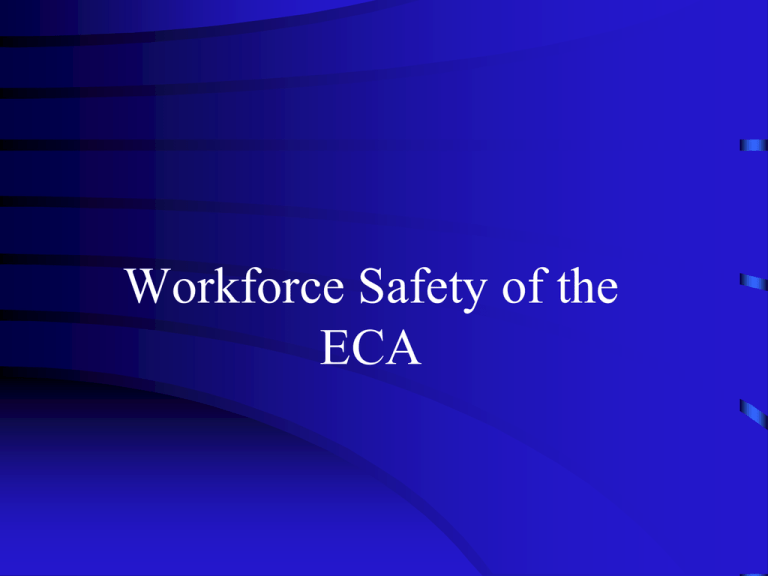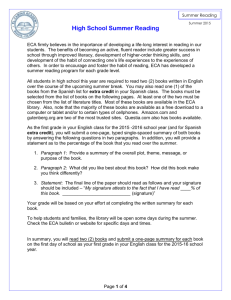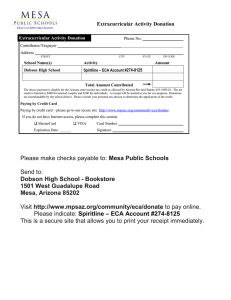Workforce Safety of the ECA
advertisement

Workforce Safety of the ECA Objectives • List possible emotional reactions that an ECA may experience. • Discuss reactions that family members may experience when confronted with death and dying. • State the steps in approaching a family that is confronting death and dying. Objectives • State the possible reactions the family of an ECA may exhibit. • Recognize signs and symptoms of critical incident stress. • State steps to help alleviate stress. • Explain the need to determine scene safety. Objectives • Discuss the importance of BSI. • Describe the steps of personal protection from airborne and bloodborne pathogens. • List personal protective equipment necessary for various situations. The Well-Being of the ECA • Personal health, safety, and well-being are vital to an EMS operation. • You must learn to recognize and protect yourself from hazards. • You must cope with mental and physical stress. Death and Dying • Changes in society have changed people’s attitudes toward death. – Life expectancy has increased. – Family mobility may mean less support for grieving people. – Death no longer commonly occurs at home, but occurs in a hospital or at an accident site such as the highway instead. – Dead loved ones are now kept at a funeral home instead of at home, so people are less used to dead bodies. Death and Dying • Death is something you will have to face. • Coming to grips with death is part of delivering care. Physical Signs of Death • Absence of circulatory and respiratory function • If the body is still warm, initiate care. • If hypothermia is present, initiate care. Presumptive Signs of Death • • • • • Unresponsive to painful stimuli Lack of pulse Absence of breath sounds Absence of eye movement No blood pressure Presumptive Signs of Death • Dependant lividity • Profound cyanosis • Decreased body temperature Definitive Signs of Death • Obvious mortal injury • Rigor mortis • Putrefaction (decomposition of body) Medical Examiner Cases • DOA • Unknown cause of death • Suicide • Violent death • Poisoning • Accidents • Criminal act Keep notes of any care provided. Stages of Grieving 1. Denial: Refusal to accept 2. Anger: Blaming others 3. Bargaining: Promise to change 4. Depression: Open expression of grief 5. Acceptance: The simple “yes” What can an ECA do? • Do helpful things. • Make simple suggestions. • Be yourself and sincere. Dealing with Family Members • Act in a calm manner. • Show concern about privacy. • Respect family’s wishes. • Be honest. • Don’t create false hope. Concerns of the Critically Injured or Dying Patient • • • • • • • • Anxiety Pain and fear Anger and hostility Depression Dependency Guilt Mental health problems Receiving unrelated bad news Caring for the Critically Ill and Injured Patients • Avoid sad and grim comments. • Orient the patient. • Be honest. Caring for the Critically Ill and Injured Patients • Acknowledge the seriousness of the condition. • Allow for hope. • Locate and notify family members. Factors Affecting Patient Reactions • Socioeconomic background • Mental disorders • Medication • Fear of medical personnel reactions • Alcohol/substance abuse • Age • Chronic diseases • Nutritional status • Guilt feelings Critical Incidents • Mass Casualty Incidents • Traumatic injury or death of child • MVA caused by EMS personnel • Serious injury or death of coworker Critical Incident Stress Management • Developed in the 1980s • Process designed to help EMS personnel deal with responses to critical incidents • Composed of trained peers and mental health professionals Components of CISM System • Pre-incident stress education • On-scene peer support • One-on-one support • Disaster support services • Defusings Components of CISM System • CISD • Follow-up services • Spouse and family support • Community outreach programs • Other wellness programs Stress Warning Signs and the Work Environment Physiological Manifestations of Stress • Rise in respirations and pulse • Increase in blood pressure • Cool, clammy skin • Dilated pupils Physiological Manifestations of Stress • Tensed muscles • Increase blood sugar levels • Perspiration • Decreased circulation to GI tract All caused by release of epinephrine Stress Warning Signs • • • • • • • • • Irritability toward family, friends, coworkers Inability to concentrate Insomnia or nightmares Anxiety Indecisiveness Guilt Loss of appetite Isolation Loss of interest in work Stress Management • Lifestyle changes – – – – – Eat healthy Exercise Relaxation Meditation, visual imagery Balance work, family, recreation and health Stress Management • Environmental Changes – Request assignments that allow more time with family and friends – Request duty assignment to less busy area • Seek professional help if needed Stress and Nutrition • Prolonged stress drains the body’s reserves. • Under stress, body’s fuel sources are consumed in large quantities. • Physical stress will deplete energy sources quicker. Stress and Nutrition • Glucose – Quickest source of energy – Taken from glycogen stored in liver • Proteins – Drawn from muscles – Long-term source of glucose Stress and Nutrition • Fats – Used by tissues for energy • Water – Conserved by exchanging sodium & potassium from kidneys • Vitamins and minerals – Vitamins B, C, and most minerals are depleted. Benefits of Exercise and Proper Nutrition • Muscles will grow and retain protein. • Bones store calcium and become stronger. • Well-balanced meals provide necessary nutrients to body. Body Substance Isolation • EMT and patients protection • Assumes all body substances are infectious Basic Protection • Hand washing – Your best protection! – Before and after patient contact – Even if gloves were worn – Soap and Water preferred – Gel if soap and water not available Basic Protection • Gloves – Vinyl, Latex or synthetic – Used with contact of body fluids – Should be changed between patient contacts Basic Protection • Eye protection – Goggles or glasses – Prescription glasses need side shields – Worn with • • • • Splashing Spiting Vomiting Spurting Basic Protection • Masks – Blood Splatter • Surgical type – Airborne disease or particles • HEPA (High Efficiency Particulate Air) • N95 Respirator Basic Protection • Gowns – Used with large volumes of blood or other body fluids – Trauma – Child birth Scene Protection • • • • • Turnout gear Gloves Helmet Eyewear Footwear Scene Protection • Body Armor Scene Protection Concealment hides your body Cover – hides and protects

